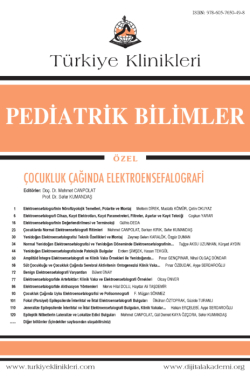Normal Electroencephalography Rhytms in Children
Mehmet CANPOLATa, Serkan KIRIKb, Sefer KUMANDAŞa
aÇocuk Nörolojisi BD, Erciyes Üniversitesi Tıp Fakültesi, Kayseri, TÜRKİYE
bÇocuk Nörolojisi Kliniği, Aydın Kadın Doğum ve Çocuk Hastanesi, Aydın, TÜRKİYE
Canpolat M, Kırık S, Kumandaş S. Çocuklarda normal elektroensefalografi ritimleri. Canpolat M, Kumandaş S, editörler. Çocukluk Çağında Elektroensefalografi. 1. Baskı. Ankara: Türkiye Klinikleri; 2019. p.23-9.
ABSTRACT
Age-related electroencephalography (EEG) changes are observed throughout childhood. While these age-related changes ocur quite rapidly during the first year of life, they continueal beit at a diminishing pace with advancing of age. These age-related changes sometimes create diagnostic difficulties for physicians. When evaluating EEG, it is very important to distinguish normal rhythms from abnormal rhythms by considering maturational changes. Thus, electrophysiologybased misdiagnoses can be prevented. This chapter, focuses on normal rhythms and their variants during the sleep-wake cycle in childhood EEG.
Keywords: Pediatric; electroencephalography; normal rhythms
Kaynak Göster
Referanslar
- Fisch BJ. Fisch and Spehlmann's EEG primer. Basic Principles of Digital and Analog EEG. 3rd ed. Amsterdam: Elsevier Science; 1999. p.159-278.
- Westmoreland B, Stockard J. The EEG in infants and children: normal patterns. Am J EEG Technol. 1977;17(4):187-207. [Crossref]
- Laoprasert P. Atlas of Pediatric EEG. 1st ed. Rochester, USA: McGraw-Hill Companies; 2011. p.1-7.
- Eisermann M, Kaminska A, Moutard ML, Soufflet C, Plouin P. Normal EEG in childhood: from neonates to adolescents. Neurophysiol Clin. 2013;43(1):35-65. [Crossref] [PubMed]
- Danker-Hopfe H. Growth and development of children with a special focus on sleep. Prog Biophys Mol Biol. 2011;107(3):333-8. [Crossref] [PubMed]
- St. Louis EK, Frey LC. Electroencephalography (EEG): An Introductory Text and Atlas of Normal and Abnormal Findings in Adults, Children and Infants. Chicago, IL: American Epilepsy Society; 2016. p.8-48.
- Kaibara M, Holloway GM, Young GB. Blume's Atlas of Pediatric and Adult Electroencephalography. 1st ed. London, UK. Lippincott Williams & Wilkins; 2011. p.65-235.
- Scher MS. Ontogeny of EEG-sleep from neonatal through infancy periods. Sleep Med. 2008;9(6):615-36. [Crossref] [PubMed]
- Hughes JR. The development of the vertex sharp transient. Clin Electroencephalogr. 1998;29(4):183-7. [Crossref] [PubMed]
- Plouin P, Kaminska A, Moutard ML, Soufflet C. Developmental aspects of normal EEG. Handb Clin Neurol. 2013;111:79-85. [Crossref] [PubMed]
- Reiher J, Carmant L. Clinical correlates and electroencephalographic characteristics of two additional patterns related to 14 and 6 per second positive spikes. Can J Neurol Sci. 1991;18(4):488-91. [Crossref] [PubMed]
- André M, Lamblin MD, d'Allest AM, CurziDascalova L, Moussalli-Salefranque F, S Nguyen The T, et al. Electroencephalography in premature and full-term infants. Developmental features and glossary. Neurophysiol Clin. 2010;40(2):59-124. [Crossref] [PubMed]
- Niedermeyer E, Lopes da Silva F. Niedermeyer's Electroencephalography: Basic Principles, Clinical Applications and Related Fields. 4th ed. Philadelphia: Lippincott, Williams & Wilkins; 1999. p.189-214.
- Westmoreland BF, Klass DW. Electroencephalography: electroencephalograms of neonates, infants and children. In: Daube J, ed. Clinical Neurophysiology. Philadelphia, USA: FA Davis; 1996. p. 104-13.
- Clarke AR, Barry RJ, McCarthy R, Selikowitz M. Age and sex effects in the EEG: Development of the normal child. Clin Neurophysiol. 2001;112(5):806-14. [Crossref] [PubMed]

